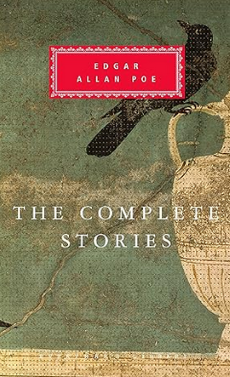The futility of escape in The Complete Stories of Edgar Allan Poe.

To prime myself for Halloween this year, I read Edgar Allan Poe’s The Complete Stories in the early mornings and in the evenings settled in to watch the 2015 Netflix series “Glitch,” about a group of small-town Australians who return from the dead.
In the show, it takes some time for “the returned” to get used to being alive again. As they adapt, each is confronted with a ghoulish constraint: They cannot stray too far from where they were resurrected; otherwise, they’ll disintegrate on the spot.
In subsequent seasons, the characters solve the boundary problem and head off to experience freedom for the first time since coming back to life. What they learn, however, is that their expanded geography brings about new and worse existential threats. For them, it’s just one damn thing after another, and escape is as exhausting as it is illusory.
Knowing Poe’s seminal influence on the horror genre, it’s not surprising that a common theme emerged from my daytime reading and nighttime viewing, a condition I can only call “the terror of solutions and all their attendant consequences.”
If the anxiety of (no)escape has been consigned to smaller canvases in the horror we now consume (haunted houses, apparitions, dissolving mental states, unstable bodies), Poe’s articulation of it is vast in comparison and deploys nothing short of the whole universe: sky, oceans, celestial bodies, and other dimensions.
Notably, he returns three times to stories about hot-air balloons. “The Unparalleled Adventure of One Hans Pfaall” tells of an eponymous hero who floats to the moon to duck his gambling debts. After an almost suffocating journey, he crash-lands in a lunar city full of ugly, earless aliens and exploding volcanoes. Suddenly, the workhouse doesn’t look so bad.
Other stories take place aboard ships where monster waves, menacing ice drifts, and killer vortexes are the norm. “Message Found in a Bottle” ends with a sailor trapped on a boat with a crew that’s not altogether human. How did he end up in such a predicament? He thought going to sea would cure his nervousness.
The moral here isn’t cheerful, but Poe’s conviction that there can be no real escape from dread is more sympathetic than pious. He, too, tried to evade confines and obliterate boundaries by making his literary experiments as expansive as possible. His narratives span seismic ranges — with stories taking place in antiquity swiftly zipping forward to the year 3830 — making him a pioneer of speculative fiction.
Other tales are beyond time altogether, and even Poe’s tone — playful, absurd, and biting before veering off into the biblical and philosophical — shows breadth. Some of his stories take on a journalistic veneer, while others try too hard to sound scientific.
It’s been established that Poe invented the detective story. His traditional horror morphs easily from well-plotted mystery into psychological thriller, sometimes going full-on slasher. Moving past gothic elements, his tales offer eclectic thoughts on perspectivism, original takes on alternative astronomy, and (yes!) even views on “mystical economics,” not to mention an amusingly out-of-place meditation on the philosophy of furniture. If the phrase, “You can run but you can’t hide,” holds true in Poe’s fiction, the consolation is an enormous and varied terrain on which to sprint.
Still, his stories didn’t scare me at first. The resolute concentration it takes to remain alert through more than 900 pages would remove the tingle from any spine. This, paired with his long, digressive sentences, works against the feeling of suspense that sustains readers through most works of horror. Yet considered as a whole, the collection’s ethos and social commentary, its concepts and subtext, should leave thoughtful readers with a few presentiments.
Namely, does every problem merit resolution? How can we weigh gains in one area against unintended consequences in another? At what point is it okay to embrace the gritty lives we have and abandon the transcendent ones we want? Poe’s inquiries disturb us by showing “unlimited betterment” for what it is: a utopian promise of modernity that most of us take as a given even as we forget (or ignore) the good that’s been lost along the way. His heroes are a lot like us, a lot like the alcoholic Poe himself, in reacting to their inevitable limitations by self-destructing.
In the compilation’s best story, “William Wilson,” the titular character attends school with another boy of the same name. In time, William learns that he and the other William also share a birthday. When the second William starts overtly imitating the first in speech and manner, the original William flees, surviving by engaging in a life of gambling, fraud, and general lawlessness. Yet no matter how far the first William goes or how well he disguises himself, the second always shows up to foil his misbegotten plans, and the cycle begins again.
Reading Poe, how frightening it is to be reminded that our worst tormentors are not coming for us because they are already inside.
Please share your thoughts on reading Edgar Allan Poe’s stories in the comments below. You can join Dorothy in next reading Pride and Prejudice, which will be the subject of her column on January 29th, 2024.
_80_120.png)
